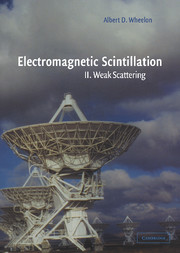Book contents
- Frontmatter
- Contents
- Preface
- 1 Introduction
- 2 The Rytov Approximation
- 3 Amplitude Variance
- 4 Spatial Covariance
- 5 The Power Spectrum and Autocorrelation
- 6 Frequency Correlations
- 7 Phase Fluctuations
- 8 Double Scattering
- 9 Field-strength Moments
- 10 Amplitude Distributions
- 11 Changes in Polarization
- 12 The Validity of the Rytov Approximation
- Appendix A Glossary of Symbols
- Appendix B Integrals of Elementary Functions
- Appendix C Integrals of Gaussian Functions
- Appendix D Bessel Functions
- Appendix E Probability Distributions
- Appendix F Delta Functions
- Appendix G Kummer Functions
- Appendix H Hypergeometric Functions
- Appendix I Aperture Averaging
- Appendix J Vector Relations
- Appendix K The Gamma Function
- Appendix L Green's Function
- Appendix M The Method of Cumulant Analysis
- Appendix N Diffraction Integrals
- Appendix O Feynman Formulas
- Author Index
- Subject Index
1 - Introduction
Published online by Cambridge University Press: 15 December 2009
- Frontmatter
- Contents
- Preface
- 1 Introduction
- 2 The Rytov Approximation
- 3 Amplitude Variance
- 4 Spatial Covariance
- 5 The Power Spectrum and Autocorrelation
- 6 Frequency Correlations
- 7 Phase Fluctuations
- 8 Double Scattering
- 9 Field-strength Moments
- 10 Amplitude Distributions
- 11 Changes in Polarization
- 12 The Validity of the Rytov Approximation
- Appendix A Glossary of Symbols
- Appendix B Integrals of Elementary Functions
- Appendix C Integrals of Gaussian Functions
- Appendix D Bessel Functions
- Appendix E Probability Distributions
- Appendix F Delta Functions
- Appendix G Kummer Functions
- Appendix H Hypergeometric Functions
- Appendix I Aperture Averaging
- Appendix J Vector Relations
- Appendix K The Gamma Function
- Appendix L Green's Function
- Appendix M The Method of Cumulant Analysis
- Appendix N Diffraction Integrals
- Appendix O Feynman Formulas
- Author Index
- Subject Index
Summary
The first volume on electromagnetic scintillation exploited geometrical optics to describe propagation in random media. That method represents an approximate solution for Maxwell's equations, which define the electromagnetic field. It was surprisingly successful in two important respects, even though it completely ignores diffraction effects.
Geometrical optics provides an accurate description for the signal-phase fluctuations imposed by a random medium. In this approximation, phase and range variations are caused by random speeding up and slowing down of the signal as it travels along the nominal ray trajectory. The phase variance estimated in this way is proportional to the distance traveled and to the first moment of the spectrum of refractive irregularities. It is therefore primarily sensitive to large eddies and diffraction effects can be safely ignored. This description is confirmed over an unusually wide range of wavelengths and propagation conditions.
The same technique was used to describe the phase difference measured between adjacent receivers. That result is needed in order to interpret observations made with microwave and optical interferometers. A similar expression characterizes the angular resolution of large telescopes in the limit of small separations. In this approach, angular errors are caused by random refractive bending of the rays as they travel through the random medium. The predicted resolution is proportional to the distance traveled and to the spectrum's third moment.
- Type
- Chapter
- Information
- Electromagnetic Scintillation , pp. 1 - 9Publisher: Cambridge University PressPrint publication year: 2003



